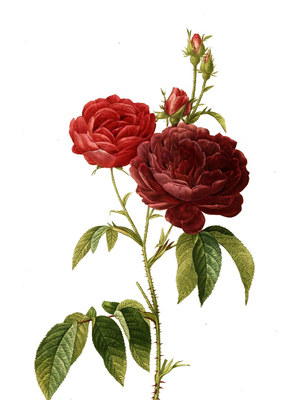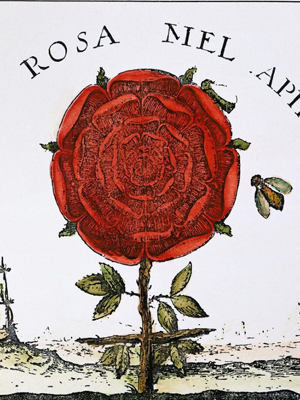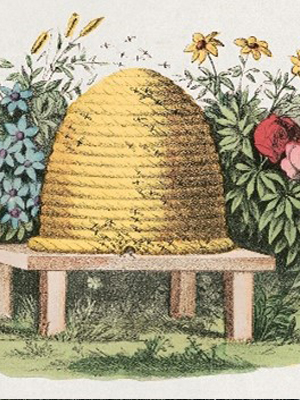
Masonic Articles and Essays
Dat Rosa Mel Apibus - Its Masonic Message
Very Ills..... Bro. Pamela McDown 33°
Date Published: 1/1/1900
The Rose is an ancient mystical symbol, pregnant with meaning, that has been used by the Mysteries for centuries. What is its connection to bees, another Masonic symbol, and the philosophical teachings of Freemasonry?
 These days I find myself thinking a lot about the world community which seems to be… off somehow. Individual lives are given to crisis and despair. Society is coming undone at the seams. Countries are on the brink. Entire blocks of humanity are fractured and banished. As so many of us go through the valleys of life, I keep pondering how best to serve humankind. Consequently, I’ve been turning back to the treasures of wisdom over the centuries to see what gems they have to offer us in this regard. I found one such symbol in Dat Rosa Mel Apibus.
These days I find myself thinking a lot about the world community which seems to be… off somehow. Individual lives are given to crisis and despair. Society is coming undone at the seams. Countries are on the brink. Entire blocks of humanity are fractured and banished. As so many of us go through the valleys of life, I keep pondering how best to serve humankind. Consequently, I’ve been turning back to the treasures of wisdom over the centuries to see what gems they have to offer us in this regard. I found one such symbol in Dat Rosa Mel Apibus.
The Latin phrase Dat Rosa Mel Apibus, means “The Rose Gives Honey to the Bees.” It is commonly attributed to the Rosicrucian tradition, most notably appearing in the works of Robert Fludd, particularly in his book "Summum Bonum (1629)." His diagrams of cosmic and human consciousness emphasized the rose as a key to spiritual awakening. More than just an image of nature’s harmony, this cryptic motto has deep alchemical and esoteric implications.
Why has this flower, delicate yet filled with thorns, become a universal symbol of the initiate’s path? What lesson for a Freemason does the rose conceal? And who are symbolically the worthy “bees” that may partake in its divine nectar?
The Rose as a Symbol of Hidden Wisdom
The Rose itself is a powerful symbol where every mystery tradition offers up somewhat different interpretations.
Recently, I was reading through Brother Paul Foster Case's writings, where he delves into some discussion of the Rose as exemplified in the Rosicrucian Order. The rose is a symbol of love, for it was the flower of Venus from a period long antedating the Christian Era. The rose and its five petals represent the five senses, and the five points of the pentagram correspond to the microcosm and man. In the Rosy Cross, the rose is placed on the cross of six squares. The cross relates to the mystery of the hexagram, which is an emblem of the macrocosm. Their conjoined significance represents both microcosm (5) and macrocosm (6). It is said that the universe opens like a rose and closes like a cross folded into a cube.”
Brother Case writes:
“When the rose is fastened to the fundamental and central square of the cross, the meaning is that the desire nature of man has been unified with the One Law that is the basis of all manifestation. Close up the cross so that it forms a cube, and the rose will be hidden within it. The center of the rose and the center of the foundation square are the same. Here is the great practical principle of true Rosicrucianism.”
“The rose is hidden within it.” In Masonic tradition, the rose is also tied to the principle of secrecy. The Latin phrase sub rosa ("under the rose") is associated with confidentiality and the transmission of hidden wisdom. Secrecy is not about exclusion but rather about safeguarding profound truths that must be earned and understood through experience. By keeping certain teachings veiled, Freemasonry’s wisdom is preserved and passed down with integrity to those who are truly prepared to receive it.
Could it be that the rose is not merely a symbol, but a living metaphor for the trials of the initiate? Do the thorns that represent suffering and sacrifice, guard the treasure within? Do those who are willing to endure the challenges of the path reach the honey at its center?
Who are the Bees?
 The phrase Dat Rosa Mel Apibus suggests that honey - the sweetness of knowledge - is not freely given to all but must be actively gathered by those who seek it.
The phrase Dat Rosa Mel Apibus suggests that honey - the sweetness of knowledge - is not freely given to all but must be actively gathered by those who seek it.
Bees are often associated with labor and industriousness, mirroring the transformative process of extracting nectar from flowers and creating honey - something entirely new. Just as bees are essential to a garden, ensuring that plants reach their full potential by bearing fruit, they also serve as a timeless emblem of life's natural progression, with its inevitable ups and downs. Despite the challenges we face, the evolution of the human soul continues, driven by the perseverance and fortitude we embody.
Bees are disciplined and operate within the hive order. Is this not reminiscent of the structure and philosophy of Freemasonry? Just as bees work together in unity, Masons are bound by fraternity and a common purpose: to serve as builders of a better world. The Great Architect of the Universe, like the Queen Bee of the hive, ensures there is order and harmony within the sacred work. Is it not the duty of every Mason to be a worker in this grand design?
But what of the honey itself? Honey is the product of labor and patience. In Freemasonry, the initiate does not simply receive knowledge but must earn it.
The Masonic Rose
Some of my most precious experiences being a freemason that I remember are with a rose in hand. Holding a rose close to my heart to honor those masons who have gone before us during the Lodge of Remembrance or smelling the sweet fragrance of the Rose at the Summer Solstice Ceremony are two examples of being in awe of its magnificence and mystery. Always, I take the rose home after the ceremony and place it in a special place. The petals stay vibrant for weeks before they dry out. There is magic associated with the rose. In aromatherapy, the smell of the rose is said to have one of the highest vibration frequencies of all essential oils.
In the Scottish Rite, particularly within the 18th degree or Knights of the Rose Croix, the rose is a symbol of love, “Amor” in Latin, which is also related to the idea of death from the word “Mors”, meaning death. The rose embracing the cross could thus represent immortality, and the way to achieve it, which is through love. In the 18th degree, the Mason experiences striking contrasts woven throughout the ritual - the shift from darkness to light, from devastation to hope which culminates in the profound and sublime experience of a mystical love only found in the chain of brotherhood.
Brother Manly P. Hall, in The Secret Teachings of All Ages, describes the Rose Croix as a bridge between the material and the spiritual, stating that the rose “signifies the unfolding of human consciousness and the revelation of divine truth.” If one gains access to the center of the rose, it speaks to the "lost word" of Masonic lore, which throws open the door to the deepest secrets of initiation.
Could this be the true meaning of the honey - that through labor and perseverance, the Mason extracts the nectar of divine truth?
Conclusion: Who Will Gather the Honey?
 In summary, the phrase Dat Rosa Mel Apibus is more than a poetic motto—it is a challenge. In trying times, there is no circumstance that does not offer some gain to the life of the soul. Whilst we all survey a troubled world, replete with many challenges and crises, profound opportunity lies ahead to rise above the shibboleths of selfish individualism and populism. How shall we serve? The answer is simple. It is with love we serve. Are we one of the bees? Will we labor to extract the divine nectar, or will we remain outside the garden, unaware of the sweetness within?
In summary, the phrase Dat Rosa Mel Apibus is more than a poetic motto—it is a challenge. In trying times, there is no circumstance that does not offer some gain to the life of the soul. Whilst we all survey a troubled world, replete with many challenges and crises, profound opportunity lies ahead to rise above the shibboleths of selfish individualism and populism. How shall we serve? The answer is simple. It is with love we serve. Are we one of the bees? Will we labor to extract the divine nectar, or will we remain outside the garden, unaware of the sweetness within?
"Mystery glows in the rose bed, the secret is hidden in the rose."
-12th-century Persian poet
